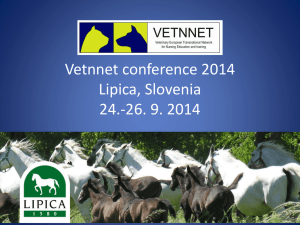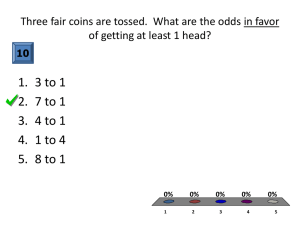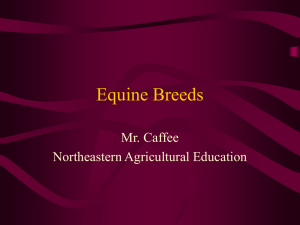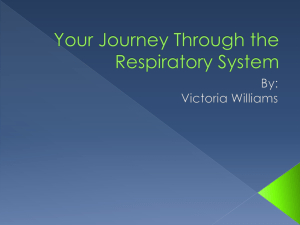Equine Science - s3.amazonaws.com
advertisement
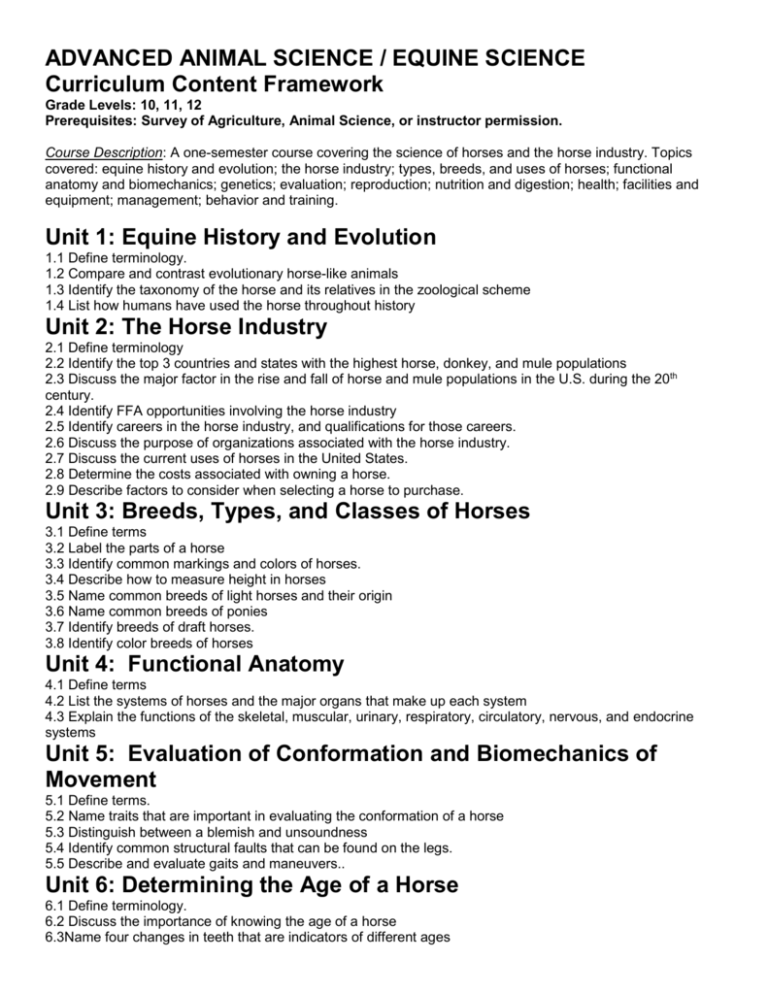
ADVANCED ANIMAL SCIENCE / EQUINE SCIENCE Curriculum Content Framework Grade Levels: 10, 11, 12 Prerequisites: Survey of Agriculture, Animal Science, or instructor permission. Course Description: A one-semester course covering the science of horses and the horse industry. Topics covered: equine history and evolution; the horse industry; types, breeds, and uses of horses; functional anatomy and biomechanics; genetics; evaluation; reproduction; nutrition and digestion; health; facilities and equipment; management; behavior and training. Unit 1: Equine History and Evolution 1.1 Define terminology. 1.2 Compare and contrast evolutionary horse-like animals 1.3 Identify the taxonomy of the horse and its relatives in the zoological scheme 1.4 List how humans have used the horse throughout history Unit 2: The Horse Industry 2.1 Define terminology 2.2 Identify the top 3 countries and states with the highest horse, donkey, and mule populations 2.3 Discuss the major factor in the rise and fall of horse and mule populations in the U.S. during the 20th century. 2.4 Identify FFA opportunities involving the horse industry 2.5 Identify careers in the horse industry, and qualifications for those careers. 2.6 Discuss the purpose of organizations associated with the horse industry. 2.7 Discuss the current uses of horses in the United States. 2.8 Determine the costs associated with owning a horse. 2.9 Describe factors to consider when selecting a horse to purchase. Unit 3: Breeds, Types, and Classes of Horses 3.1 Define terms 3.2 Label the parts of a horse 3.3 Identify common markings and colors of horses. 3.4 Describe how to measure height in horses 3.5 Name common breeds of light horses and their origin 3.6 Name common breeds of ponies 3.7 Identify breeds of draft horses. 3.8 Identify color breeds of horses Unit 4: Functional Anatomy 4.1 Define terms 4.2 List the systems of horses and the major organs that make up each system 4.3 Explain the functions of the skeletal, muscular, urinary, respiratory, circulatory, nervous, and endocrine systems Unit 5: Evaluation of Conformation and Biomechanics of Movement 5.1 Define terms. 5.2 Name traits that are important in evaluating the conformation of a horse 5.3 Distinguish between a blemish and unsoundness 5.4 Identify common structural faults that can be found on the legs. 5.5 Describe and evaluate gaits and maneuvers.. Unit 6: Determining the Age of a Horse 6.1 Define terminology. 6.2 Discuss the importance of knowing the age of a horse 6.3Name four changes in teeth that are indicators of different ages 6.4 List the temporary and permanent teeth of the horse and their approximate time of eruption 6.5 List four abnormal tooth conditions Unit 7: Genetics of Horses 7.1 Define terms 7.2 Give the correct number of chromosomes for horses, mules, donkeys, and zebras. 7.3 Discuss inheritable traits. 7.4 List lethal and detrimental genetic abnormalities. 7.5 Explain how DNA sampling is used in horse identification. Unit 8: Reproduction and Breeding 8.1 Define terms. 8.2 List and discuss the functions of the major parts of the female reproduction tract. 8.3 List and discuss the functions of the major parts of the male reproduction tract. 8.4 Describe how reproductive hormones affect the estrus cycle. 8.5 Select the average length of gestation in horses. 8.6 Describe normal parturition in horses. 8.7 List abnormal birth presentations. 8.8 Discuss the advantages and disadvantages of artificial insemination. 8.9 Discuss advantages and disadvantages of embryo transfer. 8.10 List methods of heat detection. 8.11 Recognize factors influencing breeding soundness of stallions and mares. 8.12 Describe the management of the mare and stallion prior to, during, and after the breeding season. 8.13 List methods of pregnancy testing. 8.14 Discuss proper care of the newborn foal. Unit 9: Digestion 9.1 Define terms. 9.2 Identify the parts and discuss the functions of the digestive tract. 9.3 Describe the effects of digestive enzymes. 9.4 Discuss common causes of colic. 9.5 Describe the symptoms and treatment of colic. 9.6 Describe the symptoms of internal parasitic infestation. 9.7 List the 4 most common internal parasites. 9.8 Discuss the preventions and treatments of internal parasites. 9.9 Describe the life cycle of bots. 9.10 List factors in an effective internal parasite control plan. Unit 10: Nutrition and Feeding 10.1 Define terms 10.2 List nutrients needed by horses. 10.3 List common sources of nutrients 10.4 Describe the functions of nutrients 10.5 Identify grains commonly used in horse rations. 10.6 Identify roughages commonly used in horse rations. 10.7 Identify differing nutritional needs for stages and activities of the horse’s life. 10.8 Compare the nutrient levels of feeds. Unit 11: Health and Diseases 11.1 Define Terms 11.2 Discuss signs of good health in horses 11.3 Discuss disease resistance and immunity 11.4 List methods of administering pharmaceuticals. 11.5 Discuss common infectious diseases 11.6 Discuss common noninfectious diseases 11.7 Identify and discuss the effects of common external parasites. 11.8 Discuss sanitation and management practices used for reducing or controlling parasites 11.9 Explain how a horse is checked for parasites Unit 12: Safety, Facilities, and Equipment 12.1 Define Terms 12.2 List factors to consider when planning a horse facility. 12.3 Name and compare materials used for horse facilities. 12.4 Discuss reasons for fencing, and how to select the right fence. 12.5 Name, identify, and describe the uses of styles of saddles. 12.6 Name, identify, and describe the uses of types of bits. 12.7 Discuss the proper fitting of tack. 12.8 Describe the process of haltering, saddling, and bridling a horse. 12.9 List the steps for proper mounting of a horse. 12.10 Describe how to load and haul a horse, and how to check the safety of a trailer. 12.11 Discuss safety in handling and riding a horse. Unit 13: Grooming and Hoof Care 13.1 Define terms. 13.2 Discuss the importance of proper grooming and hoof care. 13.3 List equipment and supplies used in grooming. 13.4 Label and explain the functions of internal and external parts of the hoof. 13.5 Discuss common problems of the hoof. 13.6 Identify equipment and supplies used in horseshoeing. 13.7 List different types of shoes. 13.8 Describe how to shoe a horse. Unit 14: Behavior and Training 14.1 Define terms 14.2 Describe the horse’s senses of vision, touch, smell, and hearing 14.3 Identify how to read the emotions of a horse 14.4 Explain the behaviors of horse hierarchy. 14.5 Discuss the use of lounging and round-penning. 14.6 Identify common training aids and equipment. Glossary Unit 1 - Equine History and Evolution: Evolution – refers to a process of continuous change Eohippus – the earliest known ancestor of the horse Monodactyl – having a single toe Przewalski’s Horse – the oldest species of horse still in existence. Equine – pertaining to the horse. Taxonomy – a system of naming living things. Mule – a cross between a mare and a jack Hybrid – a cross between genetically different organisms Morrill Land Grant Act – federal law which established land grant educational institutions in each state for the purpose of higher education in agriculture 10. Centaur – a mythical Greek race that were men with the bodies of horses. 11. Feral – horses that were once domesticated, but have become wild. 1. 2. 3. 4. 5. 6. 7. 8. 9. Unit 2 - The Horse Industry: 1. Rodeo – a competitive event involving cowboys competing at several events based on ranch work, many of which require the use of horses. 2. Horse Show – a sporting event involving horses competing in many different activities. 3. Racing – a competitive event involving horses competing head to head to determine the fastest at a particular gait or maneuver. 4. Dressage – a riding event or domain involving the guiding of a horse through stylized maneuvers with hand, body, and leg cues. 5. Gymkhana – a competition involving various games and speed events. 6. Jockey – a professional rider of horses in races. 7. Jumping – competitive event in which horses jump over obstacles and are ranked on height, time, and/or form. 8. Steeplechase – a competitive timed event involving cross-country jumping. 9. Polo – a competitive team sport involving a ball that is played on horseback. 10. Futurity – any competitive event involving young horses competing for the first time or in their first season. 11. Equestrian – involving the riding of horses. 12. Career Development Event – a competitive event sponsored by the FFA that includes academic and hands-on learning activities about specific career areas. 13. SAE Project – a home-, work-, or research- based project an agriculture student undertakes to gain knowledge, experience, or earn money in a specific agricultural area. 14. Proficiency Award – an FFA award given to students who excel in achievement with their SAE. Unit 3 - Breeds, Types, and Classes of Horses: Stallion – a mature male. Mare – a female who has given birth or reached the age of maturity. Dam – the mother of an animal. Sire – the father of an animal. Get – offspring of an animal. Registered – a horse whose name, birth information, and pedigree has been recorded in a breed association. 7. Grade – a horse that is not registered. 8. Foal – a young, nursing horse of either sex. 9. Colt – a male horse that has not reached sexual maturity, or the age of maturity. 10. Filly – a female horse that has not given birth or reached the age of maturity. 11. Weanling – a weaned horse that is less than a year of age. 12. Yearling – a horse between 1 and 2 years of age. 13. 2-year old – a horse between 2 and 3 years of age. 14. 3-year old – a horse between 3 and 4 years of age. 15. Gelding – a castrated male horse. 16. Aged Horse – a horse that has reached the age of maturity as defined by the breed association involved. 17. Hand – a measurement of height equaling 4 inches. 18. Draft horse – large horses bred for work. 19. Breed – a group of horses selected for their common ancestry and common characteristics. 20. Breed Registry – an organization that records information of horses of that breed. 21. Warm-Blood – a type of horse that is derived from a cross or mixture of light and draft horse breeding. 22. Cold-Blood – refers to a horse of draft breeding. 23. Hinny - an animal that is a cross between a stallion and a jennet. 24. Miniature Horse – a breed of horses selected for small size. 25. Pedigree – a record of the ancestry of an animal. 26. Stock horse – a horse with characteristics that make it suitable for ranch or cattle work. 27. Jack – a male donkey. 28. Jennet – a female donkey. 29. Light horse – a horse with characteristics that make it suitable for riding. 1. 2. 3. 4. 5. 6. Unit 4 – Functional Anatomy: 1. 2. 3. 4. 5. 6. 7. Coronary – pertaining to the heart. Dorsal – pertaining to the area of the animal with the spinal column. Herbivore – animals that subsist primarily on plants. Organ – a specialized structure that performs a specific function. Ventral – opposite of the spinal column. Nasal – pertaining to the nose. Cranial – the pertaining to the skull 8. Abdominal –the internal cavity of an animal below the diaphragm. Contains the digestive and reproductive tracts. 9. Dermal – pertaining to the skin. Unit 5 - Evaluation of Conformation and Biomechanics of Movement: Conformation – the overall shape and form of the horse’s body. Breed Character – the appearance of those physical qualities desired in a specific breed. Gait – the horse’s way of moving its legs during progression. Maneuver – a specific movement or series of movements required by an event or activity. Beat – the time when a foot or feet strike the ground. Stride – the distance between successive imprints of the same foot. Blemish – a unattractive physical trait that does not affect the usefulness of a horse. Sound – a condition of having no faults or injuries that interfere with the function and performance of the horse. 9. Unsoundness – any condition that interferes or is apt to interfere with the function and performance of the horse. 10. Femininity – those physical characteristics consistent with the female. 11. Masculinity – those physical characteristics consistent with the male. 12. Collected – a term used to describe a horse that has full c control over its legs at all gaits and is responsive to the cues of its rider. 1. 2. 3. 4. 5. 6. 7. 8. Unit 6 – Determining the Age of the Horse: 1. Hooks 2. Wolf Teeth – the first permanent premolars. 3. Floating – a dental procedure to smooth the teeth using files or drills. 4. Equine Dentistry – a career involving care of the horse’s teeth. 5. Cups – the deep indentures in the center of the surfaces in young permanent teeth. 6. Parrot-Mouth – a condition in which the upper teeth overhang the lower. 7. Monkey-Mouth – a condition in which the lower teeth project past the upper. 8. Galvayne’s Groove – a mark on the tooth used to determine the age of the horse. 9. Milk Teeth – the first set of teeth that an animal develops. 10. Smooth Mouth – a set of teeth with no visible cups. 11. Deciduous – refers to teeth that are shed and replaced. Unit 7 – Genetics of Horses: Dilution – a lessening of the intensity of the basic color of each hair, not from mixing with white hair, Lethal Gene – a genetic trait that is expressed as death Homozygous – possessing identical genes for a trait. Heterozygous – possessing different genes for a trait. Dominant gene – a gene that is expressed phenotypically. Recessive gene – a gene that is not phenotypically expressed. Partial Dominance – the heterozygote is intermediate between the two homozygotes, though not necessarily exactly intermediate, as with co-dominance. 8. Co-dominance – a type of gene action that causes the phenotype of the heterozygote to be intermediate between those of either homozygote. 9. Genotype – the genetic makeup of an animal. 10. Congenital – a condition that exists at birth. 11. Phenotype – the physical expression of a gene. 1. 2. 3. 4. 5. 6. 7. Unit 8 – Reproduction and Breeding: 1. Imprinting – the imposition of a behavior in a young animal by exposure to stimuli. 2. Colostrum – the first milk secreted by the mare before and the first day after foaling. It is high in antibodies. 3. Parturition – giving birth 4. Gestation – the time a mare is carrying a foal 5. Estrus – the period of time during the female hormonal cycle during which she will accept the male. 6. Winking – when the mare raises her tail to urinate, and the labia opens to expose the clitoris while she assumes a mating position. 7. Artificial Insemination – introduces sperm cells into the female reproductive tract by means other than natural service. 8. Embryo Transfer – the transfer of developing embryos from the uterus of a donor mare, and implanting them into the uterus of a receiver mare. 9. Lactation – the period of giving milk 10. Abortion – premature termination of a pregnancy. 11. Waxing – when mammary secretions leak from and harden on the teats, giving a waxy appearance. A sign of impending parturition. 12. Foal Heat – the first estrus period following parturition, usually about 9 days after foaling 13. Heat – another word for estrus. The time during the female reproductive cycle when a female is receptive to the male. 14. Maiden Mare – a virgin mare that has not been bred, nor had a foal 15. Open Mare – a mare that is not pregnant 16. Pasture Mating – natural mating. 17. Hand Mating – breeding that is closely monitored by the handler. 18. Settle – to become pregnant 19. Silent Heat – an estrus period without symptoms Unit 9 –Digestion: 1. 2. 3. 4. 5. 6. 7. 8. Absorption – to take into the body by various means. Anthelmintics – drugs used to treat worms. Host – an organism from which a parasite obtains food. Parasite – organisms that live in or on an organism of another species for the purpose of obtaining food. Intermediate Host – an organism that a parasite lives in or on during a portion of its life cycle. Not the final host. Enzymes – a substance that increases the rate of a chemical reaction. Digestion – the breakdown of foods in the digestive tract into substances that may be absorbed by the body. Colic – a broad term to describe abdominal pain. Unit 10 - Nutrition and Feeding: 1. Ration – the feed and nutrients an animal takes in during a 24 hour period. 2. Balanced Ration - the feed and nutrients an animal takes in during a 24 hour period, with the nutrients necessary for optimum performance. 3. Amino Acids – the nutritional building blocks of the body’s proteins. 4. Dehydration – an abnormal depletion of the body’s fluids. 5. Nonruminants – a monogastric animal or one without a functional rumen. 6. Concentrates –feedstuffs that are high in energy and low in fiber. 7. Roughages – feedstuffs that are high in fiber and low in energy. 8. Supplements - a substance added to the ration in small amounts to perform a specific nutritional function. Unit 11 - Health and Diseases: 1. 2. 3. 4. 5. 6. 7. Infectious Disease – a disease caused by a pathogenic organism. Non-infectious Disease – a disease caused by factors other than pathogens Pathogen – a living organism which causes disease. Carrier – an animal which harbors a pathogen without showing symptoms of disease. Vector – a living organism which harbors a pathogen, but is not affected by it. Fomite – an inanimate object which harbors a pathogen. Active Immunity – resistance to disease which is achieved when an animal is challenged and stimulated to produce its own antibodies. 8. Passive Immunity – resistance to disease which is achieved when an animal receives antibodies from an outside source. 9. Antibodies- large protein molecules in the blood that destroy pathogens. 10. Antibiotics – substance that kills or inhibits the growth of bacteria. 11. Disease – any departure from the normal state of health. 12. Toxins – poisons. 13. Vaccine – a substance introduced into an animal to stimulate the immune system to produce antibodies. 14. Condition Score – a subjective ranking of the overall body fat of a horse. 15. Acute disease – a disease with a short incubation period and a short duration. 16. Chronic disease – a disease with a long incubation period and a long duration. Unit 12 - Safety, Facilities, and Equipment: 1. 2. 3. 4. 5. 6. 7. 8. Tack – all the equipment needed for a horse. Nearside – the left side, traditionally the side for mounting. Offside – the right side, traditionally the side opposite mounting. Stall – a small enclosure for housing a horse. Bedding – material placed on the floor of a stall for cushion and absorption of waste. Hitch – the apparatus for attaching a trailer to a tow vehicle. Cross-Tying –a method of tying a horse’s head with two ropes. Boarding – paying to keep a horse at another’s facility. Unit 13 - Grooming and Hoof Care: 1. 2. 3. 4. 5. Farrier – (horseshoer) a person who cares for a horse’s feet, including attaching shoes. Founder – (laminitis) an inflammation of the sensitive laminae of the hoof. Cold-fitting – fitting shoes to a horse’s hoof without heating them. Hot-fitting – fitting shoes to a horse’s hoof by heating them for easier shaping. Bridle-path – clipped area of the mane behind the horse’s ears for the bridle to rest on. Unit 14 – Behavior and Training: 1. Desensitization – gradually increasing exposure to a frightening or anxiety-producing stimulus until the animal’s tolerance level is raised. 2. Cue – a method of communication with the horse that may involve the voice, hands, body, legs, feet, or training aids. 3. Reinforcement – repetition of response to a behavior. 4. Disposition – the normal temperament or attitude of a horse. 5. Unconditioned Response – a natural, instinctive response to a stimulus. 6. Conditioned Response – a learned response to a stimulus.




